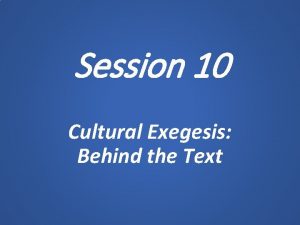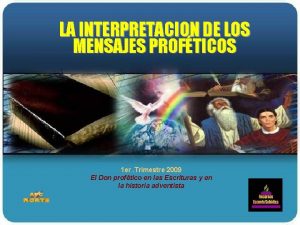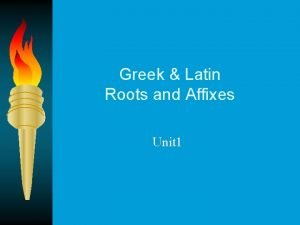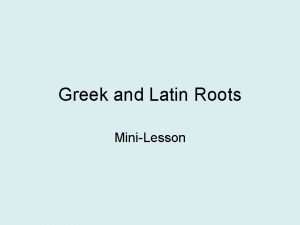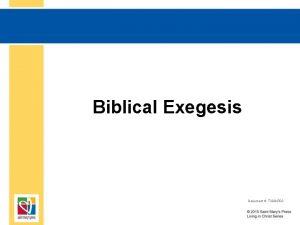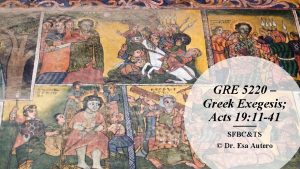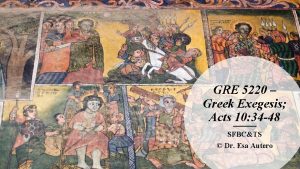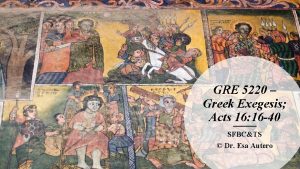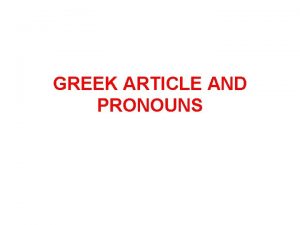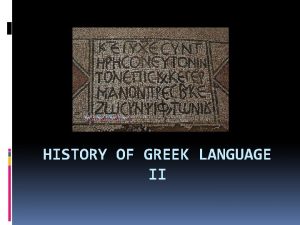The Greek Article and Exegesis Greek Article The
























































- Slides: 56

The Greek Article and Exegesis

Greek Article: The Problem • E. g. νο μος vs ὁ νο μος in Romans/Galatians • Anarthrous instances of νο μος refer to law in general (i. e. , it has inde finite force) or to ‘its quality as law’ (Sanday & Headlam). versus • ‘The view. . . that it was Paul’s custom to place the article before νο μος when he was using it with reference to the OT law and that, when he omits the article, he is using the word in a general sense, cannot be sustained’ (Cranfield).

Grammaticalisation path for Articles (Joseph Greenberg) • ‘Demonstratives … the “stem cells” from which … articles & relative pronouns arise’. Stages of Development I: definite II (bleaching): cognitively identifiable III: + nominaliser

definite versus cognitively identifiable • definite(ness): ‘a term used in GRAMMAR and SEMANTICS to refer to a specific, identifiable entity (or class of entities)’ (Crystal). • identifiable: ‘broader and less restricted’ because the ‘article’s semantic specificity’ has been bleached out (Runge). • ‘specific, identifiable’ > ‘identifiable’.

definite versus cognitively identifiable: Rom 5: 3 b-5 a …εἰδότες ὅτι ἡ θλῖψις ὑπομονὴν κατεργάζεται, 4 ἡ δὲ ὑπομονὴ δοκιμήν, ἡ δὲ δοκιμὴ ἐλπίδα. 5 ἡ δὲ ἐλπὶς οὐ καταισχύνει, • Greek: Each topic is arthrous, because identifiable from immediate context. • English: Each topic is anarthrous, because abstract, does not refer to a specific entity or class of entities. 3

definite versus cognitively identifiable: Luke 8: 8 • Ὁ ἔχων ὦτα ἀκούειν • The intended referent is grammatically indefinite, yet cognitively identifiable from the context as anyone who has just heard what Jesus has said.

Dissertations on Greek article in 2013 • Stephen Janssen, The Greek Article in Pauline Literature: Traditional Grammar and Discourse Perspec tives(DTS). • Ronald D. Peters, The Greek Article: A Functional Grammar of ὁ items in the Greek New Testament with Special Emphasis on the Greek Article (Mc. Master). Both: Article signals cognitive identifiability, rather than definiteness.



Article: Cognitively identifiable: Luke 1: 1 Ἐπειδήπερ πολλοὶ ἐπεχείρησαν ἀνατάξασθαι διήγησιν περὶ τῶν πεπληρο φορημένων ἐν ἡμῖν πραγμάτων • Luke expects ‘most excellent Theopholous’ to be able to identify the referent of ‘the things that have been fulfilled among us’.

Identifying the intended referent • Means include anaphora and encyclopaedic knowledge (Lambrecht). • τὸ ἐν αὐτοῖς πνεῦμα Χριστοῦ (1 Pe 1: 11) identifiable through anaphora (ἐν ἁγιασμῷ πνεύματος— 2). • περὶ τῶν πεπληροφορημένων ἐν ἡμῖν πραγμάτων (Lk 1: 1) identifiable from encyclopaedic knowledge.

Anaphora and Encyclopaedic Knowledge Default pattern: • Activating references are anarthrous. • Further references are arthrous (involve anaphora).

Anaphora and Encyclopaedic Knowledge • Prototypical noun phrases: usually identifiable through anaphora. • Nominalised forms (e. g. infinitives, participles): identifiability is ‘more likely to derive from encyclopedic knowledge or pragmatic bootstrapping’ (Runge). ἰδοὺ ἐξῆλθεν ὁ σπείρων τοῦ σπείρειν (Mt 13: 3) identifiable from encyclopaedic knowledge as to how sowers of that time sowed their seed.

Anarthrous references to identifiable entities (Activating references are anarthrous: not yet identifiable; e. g. ὑπομονὴν & δοκιμήν —Rom 5: 3 4). • Acts 10: References to Peter: 26: ὁ Πέτρος 34: Ἀνοίξας δὲ Πέτρος τὸ στόμα εἶπεν

Anarthrous references to identifiable entities • An unmarked-marked pair, with the article +Identifiable. • Entities with the article such as ὁ Πέτρος are +Identifiable. • The absence of the article (Ø Πέτρος) does NOT mean that the referent is not identifiable.

Anarthrous references to identifiable entities • Article is +Identifiable (Janssen, Peters). • Peters (following Porter): Article is marked member of a ‘privative opposition’, so is prominent: +Identifiable, +Salient. • Linguisti cally suspect; linguists do not expect two features to distinguish the members of a closed, two member set. • Runge on confusion between symmetrical and asymmetrical markedness.

Anarthrous references to identifiable entities • ‘Such references appear to have the rheto rical effect of highlighting that speech’. When the speech concerned is ‘a response by the address of the last speech, … references to the speaker are typically anarthrous only if the speech is the climax of the episode or otherwise is of particular importance. ’ (Heimerdinger & Levinsohn)


Anarthrous references to identifiable entities • … give prominence to their referent: θεο ς in Galatians. 1: 1 (θεοῦ πατρὸς): activated anarthrously. 3: 11 a (ο τι δε ε ν νο μω ου δει ς δικαιου ται παρα τω θεω δη λον ‘Now it is evident that no man is justified before God by the LAW’—NRSV): focal constituents are ου δει ς and δη λον, but not παρα τω θεω .

Anarthrous references to identifiable entities • … give prominence to their referent: θεο ς in Galatians. 2: 19 b (ε γω γα ρ δια νο μου νο μω α πε θανον, ι να θεω ζη σω): θεω is contrasted with νο μω. It is focal and central to the argument.

Anarthrous references to identifiable entities • … give prominence to their referent: πνευ μα in Galatians. 3: 2 b (ε ξ ε ργων νο μου το πνευ μα ε λα βετε η ε ξ α κοη ς πι στεως; ) 3: 3 b (ε ναρξα μενοι πνευ ματι νυ ν σαρκι ε πιτελει σθε; ) • Focus of 2 b: contrast between ‘by works of law’ and ‘by hearing with faith’. • Focus of 3 b: contrast between ‘in the Spirit’ and ‘in the flesh’.


Anarthrous references to identifiable entities • Propositional topics tend to be arthrous. • Prominent focal constituents are often anarthrous. Application to predicate nominatives: • ‘Generally speaking, the subject will be distinguished from the predicate nominative by having the article’ (Wallace)

Anarthrous references to identifiable entities • Propositional topics tend to be arthrous. • Prominent focal constituents: often anarthrous. Application to predicate nominatives (Colwell) : • ‘Definite predicate nouns which precede the verb usually lack the article’. [Such nouns] ‘cannot be translated as an indefinite or a “qualitative” noun solely because of the absence of the article; if the context suggests that the predicate is definite, it should be translated as a definite noun…’

Anarthrous references to identifiable entities Jn 1: 49 (Ῥαββί, σὺ εἶ ὁ υἱὸς τοῦ θεοῦ, σὺ βασιλεὺς εἶ τοῦ Ἰσραήλ— UBS) • The articular variant (σὺ εἶ ὁ βασιλεὺς τοῦ Ἰσραήλ) suggests that βασιλεὺς τοῦ Ἰσραήλ is active and identifiable. • Preposing focal βασιλεὺς ‘emphasises’ / gives it prominence. • Omitting the article adds to its prominence.

Presence versus absence of the article in 1 Peter • Nouns/Noun Phrases: πνεῦμα; Χριστός; arthrous references to entities that have not featured previously in the letter • The article with participles • The article with infinitives.


Presence versus absence of the article in 1 Peter: πνεῦμα 1: 12 (ἃ νῦν ἀνηγγέλη ὑμῖν διὰ τῶν εὐαγγελισαμέ-νων ὑμᾶς [ἐν] πνεύματι ἁγίῳ ἀποσταλέντι ἀπ’ οὐρανοῦ). Exegetical options • Identifiable (‘the same Spirit who inspired the prophets has been sent from heaven to inspire the messengers’—Davids) and focally prominent. • Not identifiable: ‘the full effusion of the Spirit now’ is different from ‘His limited working in the prophets’ (Mason).

Presence versus absence of the article in 1 Peter: πνεῦμα 3: 4 (ἀλλ’ ὁ κρυπτὸς τῆς καρδίας ἄνθρωπος ἐν τῷ ἀφθάρτῳ τοῦ πραέως καὶ ἡσυχίου πνεύματος) • Refers not to the Holy Spirit, but to ‘the character of the human spirit or the human spirit as influenced by God’s grace’ (Davids). • Arthrous: identifiable by relating it to something in the context; e. g. , ‘the purity and reverence’ of the lives of the wives (v 2).

Presence versus absence of the article in 1 Peter: πνεῦμα 3: 18 19 (θανατωθεὶς μὲν σαρκὶ ζῳοποιηθεὶς δὲ πνεύματι ἐν ᾧ καὶ τοῖς ἐν φυλακῇ πνεύμασιν πορευθεὶς…) 1. ‘Patristic interpreters commonly viewed [σαρκὶ & πνεύματι] as referring to the body and the spirit of Jesus’. Rejected because it ‘suggests that Jesus’ spirit was at some point “dead, ” an unthinkable notion within the broader confines of NT theology’ (Dubis).

Presence versus absence of the article in 1 Peter: πνεῦμα 3: 18 19 (θανατωθεὶς μὲν σαρκὶ ζῳοποιηθεὶς δὲ πνεύματι ἐν ᾧ καὶ τοῖς ἐν φυλακῇ πνεύμασιν πορευθεὶς…) 2. σαρκὶ and πνεύματι ‘refer to two modes or spheres of existence, not constituent parts of Jesus’ (Dubis). ‘[T]he second phrase does not refer to Christ disembodied, but to Christ risen to life on a new plane’ (France). ‘in his spirit’ (Barclay).

Presence versus absence of the article in 1 Peter: πνεῦμα 3: 18 19 (θανατωθεὶς μὲν σαρκὶ ζῳοποιηθεὶς δὲ πνεύματι ἐν ᾧ καὶ τοῖς ἐν φυλακῇ πνεύμασιν πορευθεὶς…) 3. Both σαρκὶ & πνεύματι are datives of instru ment or agency: Jesus was ‘put to death by humans, but made alive by the Spirit’ (Achtemier). 4. θανατωθεὶς … σαρκὶ refers to the bodily death of Jesus (‘in the body’—NIV), ζῳοποιηθεὶς … πνεύματι refers to Jesus’ resurrection, with πνεύματι being a dative of agency’ (‘by the Spirit’ —NIV).

Presence versus absence of the article in 1 Peter: πνεῦμα 3: 18 19 (θανατωθεὶς μὲν σαρκὶ ζῳοποιηθεὶς δὲ πνεύματι ἐν ᾧ καὶ τοῖς ἐν φυλακῇ πνεύμασιν πορευθεὶς…) • πνεύματι is focally prominent, contrasting with σαρκὶ in the previous clause, so the entity may be cognitively identifiable. • The anarthrous nature of πνεύματι presents no problem for either ‘in his spirit’ (Barclay) or ‘by the Spirit’ (NIV).

Presence versus absence of the article in 1 Peter: πνεῦμα in 3: 1819 θανατωθεὶς μὲν σαρκὶ ζῳοποιηθεὶς δὲ πνεύματι ἐν ᾧ καὶ τοῖς ἐν φυλακῇ πνεύμασιν πορευθεὶς… • τοῖς ἐν φυλακῇ πνεύμασιν: identifiable, even though not previously mentioned. • Natural candidate for anaphoric reference: πνεύματι. • Second interpretation (‘in the sphere of “the spirit”’—Beare) makes ‘the spirits in prison’ accessible, in line with the extra Biblical

Presence versus absence of the article in 1 Peter: Χριστός • Ἰησοῦς Χριστός is always anarthrous. • Χριστός is arthrous only three times. • Χριστός is anarthrous even when the topic of a clause; e. g. Χριστοῦ οὖν παθόντος σαρκὶ (4: 1 a). • Χριστός is also anarthrous within an arthrous phrase; e. g. τὸ ἐν αὐτοῖς πνεῦμα Χριστοῦ (1: 11).

Presence versus absence of the article in 1 Peter: Χριστός 3: 15: κύριον δὲ τὸν Χριστὸν ἁγιάσατε ἐν ταῖς καρδίαις ὑμῶν • Adaptation of Is 8: 13 (LXX), with τὸν Χριστὸν replacing αὐτὸν. • If Χριστὸν is attributive and Peter’s intention is to identify the κύριον of the quote from Isaiah as the Messiah, then the sense of κύριον … τὸν Χριστὸν is ‘[the] Lord who is the Christ’.

Presence versus absence of the article in 1 Peter: Χριστός 4: 13: καθὸ κοινωνεῖτε τοῖς τοῦ Χριστοῦ παθήμασιν / χαίρετε, ἵνα καὶ ἐν τῇ ἀποκαλύψει τῆς δόξης αὐτοῦ χαρῆτε (5: 1 is similar) • Christ’s sufferings and glory are contrasted. • τοῖς Χριστοῦ παθήμασιν would make Χριστοῦ prominent. • The arthrous reference directs attention more to παθήμασιν (clause final: prominent).

Presence versus absence of the article in 1 Peter: Χριστός 1: 11: προμαρτυρόμενον τὰ εἰς Χριστὸν παθήματα καὶ τὰς μετὰ ταῦτα δόξας. • The first reference in the letter to Christ’s sufferings, as distinct from the recipients’ trials (vv 6 7). εἰς Χριστὸν is focally prominent.

Presence versus absence of the article in 1 Peter • Arthrous genitive modifier preceding head noun: information expressed by genitive is more established than that of head noun. 1: 17 (τὸν τῆς παροικίας ὑμῶν χρόνον): ‘exile’ was activated in 1: 1. 3: 1 (διὰ τῆς τῶν γυναικῶν ἀναστροφῆς): ‘wives’ was activated earlier in 3: 1. 3: 20 (ἡ τοῦ θεοῦ μακροθυμία): ‘God’ was referred to in 3: 17.

Presence versus absence of the article in 1 Peter • Arthrous genitive modifier preceding head noun: information expressed by genitive is more established than that of head noun. 4: 4 (εἰς τὴν αὐτὴν τῆς ἀσωτίας ἀνάχυσιν): near synonym of ἀσωτίας used in 4: 3. 4: 14 (τὸ τῆς δόξης καὶ τὸ τοῦ θεοῦ πνεῦμα): ‘glory’ and ‘God’ were both referred to in 10, πνεῦμα was last used in 6, the last clear reference to the Holy Spirit was in 1: 12.

Presence versus absence of the article in 1 Peter • Arthrous genitive modifier preceding head noun: information expressed by genitive is more established than that of head noun. 2: 15 (τὴν τῶν ἀφρόνων ἀνθρώπων ἀγνωσίαν): ‘(above designa ted: those viz. who καταλα-λοῦσιν ὑμῶν ὡς κακοποιῶν [12]; not “of foolish men” in general…)’ (Alford). The arthrous genitive directs attention to the ignorance (ἀγνωσίαν) of such foolish men who ‘malign you as evildoers’ (NRSV).

Presence versus absence of the article in 1 Peter 2: 2 (τὸ λογικὸν ἄδολον γάλα): an arthrous reference to an entity that has not featured previously in the letter. • Identifiable. Most commentators follow KJV (‘desire the sincere milk of the word’) in relating it to τὸ ῥῆμα τὸ εὐαγγελισθὲν εἰς ὑμᾶς (1: 25).

Presence vs absence of the article in 1 Peter: Participial Clauses Head N(P) + arthrous participial clause. • Head NP may be arthrous or anarthrous, depending on whether it is identi fiable (e. g. τὸ ῥῆμα τὸ εὐαγγελισθὲν εἰς ὑμᾶς— 1: 25) or not (χρυσίου τοῦ ἀπολλυμένου— 1: 7). • The article that introduces the participle marks what follows as identifiable. • The reader is to treat the participle as attributive to the head noun (translate with a relative clause).

Presence vs absence of the article in 1 Peter: Participial Clauses The arthrous participle itself is the head. • Is the article simply a marker of nominalisation (Greenberg’s Stage III)? • With singular referents, still identifiable. E. g. when some characteristic of God is cited in a participial clause, without specifying that He is the referent, as in 1: 17: τὸν ἀπροσωπο λήμπτως κρίνοντα κατὰ τὸ ἑκάστου ἔργον.

Presence vs absence of the article in 1 Peter: Participial Clauses The arthrous participle itself is the head. • With singular referents, identifiable. • 3: 13: the referent of τίς ὁ κακώσων ὑμᾶς is easily identified with anarthrous ποιοῦντας κακά in v 12 (quoted from Ps 34 (33: 17 LXX).

Presence vs absence of the article in 1 Peter: Participial Clauses The arthrous participle itself is the head. • With plural referents, often identifiable, too. • 3: 16: οἱ ἐπηρεάζοντες can readily be related to καταλαλεῖσθε (v 15). • Even in 1: 12 (διὰ τῶν εὐαγγελισαμένων ὑμᾶς [ἐν] πνεύματι ἁγίῳ), it can be argued that the referent is identifiable because someone must have preached the Gospel to the recipients.

Presence vs absence of the article in 1 Peter: Participial Clauses • Conclusion: When a participle is arthrous in 1 Peter, the article retains its identifiable function.



Presence vs absence of the article in 1 Peter: Infinitival Clauses Usually anarthrous. • Following ω στε, presents ‘the intended or contemplated result’ (Selwyn) in 1: 21: δι’ ὑμᾶς τοὺς δι’ αὐτοῦ πιστοὺς εἰς θεὸν τὸν ἐγείραντα αὐτὸν ἐκ νεκρῶν καὶ δόξαν αὐτῷ δόντα, ὥστε τὴν πίστιν ὑμῶν καὶ ἐλπίδα εἶναι εἰς θεόν. • ω στε is never followed by an arthrous infinitive.

Presence vs absence of the article in 1 Peter: Infinitival Clauses Arthrous infinitives: four times in 1 Peter: • two introduced with τοῦ (3: 10, 4: 17); • two introduced with εἰς το (3: 7, 4: 2).

Presence vs absence of the article in 1 Peter: Infinitival Clauses Arthrous infinitives introduced with τοῦ. • Referent is always identifiable (e. g. ἰδοὺ ἐξῆλθεν ὁ σπείρων τοῦ σπείρειν—Mt 13: 3). • 1 Pe 3: 10 (καὶ χείλη τοῦ μὴ λαλῆσαι δόλον): LXX quote. Infinitival clause relates both to χείλη and to parallel παυσάτω τὴν γλῶσσαν ἀπὸ κακοῦ. • 4: 17 ([ὁ] καιρὸς τοῦ ἄρξασθαι τὸ κρίμα ἀπὸ τοῦ οἴκου τοῦ θεοῦ): identifiable from earlier references to judgement (e. g. κρῖναι ζῶντας καὶ νεκρούς— 4: 5).

Presence vs absence of the article in 1 Peter: Infinitival Clauses Arthrous infinitives introduced with εἰς το. • Following a preposition, ‘the infinitive is always articular’ (Wallace). • It may be no more than a marker of nominalisation (‘emphasizing the infinitive’s substantival characteristics’—Porter). • ‘formulating a description of the article’s function with infinitives presents a challenge … With an infinitive, the process is the … thing that is identified’ (Peters).

Presence vs absence of the article in 1 Peter: Infinitival Clauses Arthrous infinitives introduced with εἰς το. • 1 Pe 4: 2 (εἰς τὸ μηκέτι ἀνθρώπων ἐπιθυμίαις ἀλλὰ θελήματι θεοῦ τὸν ἐπίλοιπον ἐν σαρκὶ βιῶσαι χρόνον): It is not difficult to find an identifiable relation between the infinitival clause and the previous clause (ὁ παθὼν σαρκὶ πέπαυται ἁμαρτίας).

Presence vs absence of the article in 1 Peter: Infinitival Clauses Arthrous infinitives introduced with εἰς το. • 1 Pe 3: 7 (εἰς τὸ μὴ ἐγκόπτεσθαι τὰς προσευχὰς ὑμῶν): The reference to ‘your prayers’ is also arthrous, even though this is the first time that Peter explicitly refers to prayer. • ‘Probably Peter also has in view the joint prayers of the couple. Husband wife are to pray together; their home becomes a temple where they together approach God in the worship of a holy priesthood, offering up spiritual sacrifices [2: 5]. ’ (Clowney)

Conclusions • The Greek article indicates that the entity concerned is cognitively identifiable, rather than definite. • Identifiability is achieved either through anaphora or by appealing to the recipients’ encyclopaedic knowledge. • In 1 Peter, it is possible to argue that the article always indicates that the referent is identifiable, even when followed by a participle or infinitive.
 Exgesis
Exgesis Cultural exegesis definition
Cultural exegesis definition Exégesis etimología
Exégesis etimología Hát kết hợp bộ gõ cơ thể
Hát kết hợp bộ gõ cơ thể Frameset trong html5
Frameset trong html5 Bổ thể
Bổ thể Tỉ lệ cơ thể trẻ em
Tỉ lệ cơ thể trẻ em Voi kéo gỗ như thế nào
Voi kéo gỗ như thế nào Glasgow thang điểm
Glasgow thang điểm Chúa yêu trần thế alleluia
Chúa yêu trần thế alleluia Môn thể thao bắt đầu bằng chữ đua
Môn thể thao bắt đầu bằng chữ đua Thế nào là hệ số cao nhất
Thế nào là hệ số cao nhất Các châu lục và đại dương trên thế giới
Các châu lục và đại dương trên thế giới Cong thức tính động năng
Cong thức tính động năng Trời xanh đây là của chúng ta thể thơ
Trời xanh đây là của chúng ta thể thơ Cách giải mật thư tọa độ
Cách giải mật thư tọa độ Phép trừ bù
Phép trừ bù Phản ứng thế ankan
Phản ứng thế ankan Các châu lục và đại dương trên thế giới
Các châu lục và đại dương trên thế giới Thể thơ truyền thống
Thể thơ truyền thống Quá trình desamine hóa có thể tạo ra
Quá trình desamine hóa có thể tạo ra Một số thể thơ truyền thống
Một số thể thơ truyền thống Cái miệng bé xinh thế chỉ nói điều hay thôi
Cái miệng bé xinh thế chỉ nói điều hay thôi Vẽ hình chiếu vuông góc của vật thể sau
Vẽ hình chiếu vuông góc của vật thể sau Nguyên nhân của sự mỏi cơ sinh 8
Nguyên nhân của sự mỏi cơ sinh 8 đặc điểm cơ thể của người tối cổ
đặc điểm cơ thể của người tối cổ Ví dụ về giọng cùng tên
Ví dụ về giọng cùng tên Vẽ hình chiếu đứng bằng cạnh của vật thể
Vẽ hình chiếu đứng bằng cạnh của vật thể Vẽ hình chiếu vuông góc của vật thể sau
Vẽ hình chiếu vuông góc của vật thể sau Thẻ vin
Thẻ vin đại từ thay thế
đại từ thay thế điện thế nghỉ
điện thế nghỉ Tư thế ngồi viết
Tư thế ngồi viết Diễn thế sinh thái là
Diễn thế sinh thái là Các loại đột biến cấu trúc nhiễm sắc thể
Các loại đột biến cấu trúc nhiễm sắc thể Số nguyên tố là gì
Số nguyên tố là gì Tư thế ngồi viết
Tư thế ngồi viết Lời thề hippocrates
Lời thề hippocrates Thiếu nhi thế giới liên hoan
Thiếu nhi thế giới liên hoan ưu thế lai là gì
ưu thế lai là gì Hổ đẻ mỗi lứa mấy con
Hổ đẻ mỗi lứa mấy con Sự nuôi và dạy con của hươu
Sự nuôi và dạy con của hươu Hệ hô hấp
Hệ hô hấp Từ ngữ thể hiện lòng nhân hậu
Từ ngữ thể hiện lòng nhân hậu Thế nào là mạng điện lắp đặt kiểu nổi
Thế nào là mạng điện lắp đặt kiểu nổi What is the greek miracle in greek mythology
What is the greek miracle in greek mythology Article about to entertain to persuade to inform
Article about to entertain to persuade to inform Code of ethics for professional teachers article 7
Code of ethics for professional teachers article 7 Kryptos last 97 characters
Kryptos last 97 characters Article and demonstrative
Article and demonstrative Feature story newspaper
Feature story newspaper Fact signal words list
Fact signal words list Agenda web definite and indefinite article
Agenda web definite and indefinite article Greek and latin roots and affixes unit 2 answer key
Greek and latin roots and affixes unit 2 answer key Ante root word examples
Ante root word examples Latin and greek roots prefixes and suffixes
Latin and greek roots prefixes and suffixes How to write a school magazine
How to write a school magazine

